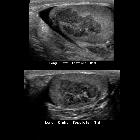congenital adrenal hyperplasia

Newborn with
ambiguous genitalia. Sagittal (above) and transverse (below) US of the kidneys shows enlarged hypoechoic lesions superior to the kidneys which have a triangular shape on sagittal images and a cerebriform shape on transverse images.The diagnosis was congenital adrenal hyperplasia.

Congenital
adrenal hyperplasia • Congenital adrenal hyperplasia - Ganzer Fall bei Radiopaedia

Congenital
adrenal hyperplasia • Female pseudohermaphroditism - Ganzer Fall bei Radiopaedia

Congenital
adrenal hyperplasia • Testicular adrenal rests - Ganzer Fall bei Radiopaedia

Congenital
adrenal hyperplasia • Congenital adrenal hyperplasia - Ganzer Fall bei Radiopaedia

Congenital
adrenal hyperplasia • Congenital adrenal hyperplasia - Ganzer Fall bei Radiopaedia

Teenager with
congenital adrenal hyperplasia. Sagittal US of the bilateral testicles shows cerebriform appearing adrenal tissue within each testicle.The diagnosis was congenital adrenal hyperplasia with bilateral testicular adrenal rests.
Congenital adrenal hyperplasia (CAH) (also known as adrenogenital syndrome) is a form of adrenal hyperplasia related to a variety of autosomal recessive disorders in adrenal steroidogenesis; characterized by low cortisol, low aldosterone, and androgen excess.
Clinical presentation
- virilization/genital ambiguity of female fetuses (due to androgen excess )
- electrolyte imbalance related to a salt-losing crisis
- dehydration
- testicular masses
Pathology
Congenital adrenal hyperplasia is an autosomal recessive disorder of congenital cortisol synthesis enzyme deficiency:
- 21-alpha-hydroxylase deficiency: ~90% of cases
- 11-beta-hydroxylase deficiency
Radiographic features
Ultrasound
- bilateral enlarged adrenal glands: size criteria are still debated (some suggest limb width >4 mm and length >20 mm)
- wrinkled surface of adrenals
- cerebriform pattern of the adrenal glands: characteristic sign
- normal ultrasound appearances may also be seen
- testicular masses may be identified representing adrenal rest tissue (see the article on testicular adrenal rests)
Differential diagnosis
- normal neonatal adrenal: can be differentiated from congenital adrenal hyperplasia (CAH) by the characteristic cerebriform appearance on sonography in CAH
Siehe auch:
und weiter:

 Assoziationen und Differentialdiagnosen zu Adrenogenitales Syndrom:
Assoziationen und Differentialdiagnosen zu Adrenogenitales Syndrom:
